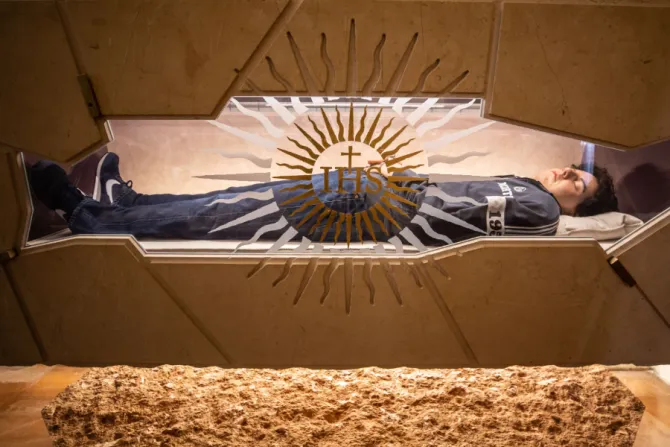ACI Prensa Staff, May 28, 2024 / 16:10 pm
The news of the upcoming canonization of Blessed Carlo Acutis, the Italian teenager with a passion for computers and the Eucharist, has people wanting to know about the circumstances of his death and the place where his body rests.
Acutis died at the young age of 15 in 2006 from acute promyelocytic leukemia (M3), which poses a much higher death rate than other forms of leukemia.
According to the Spanish Association of People Affected by Lymphoma, Myeloma, and Leukemia (AEAL), the high mortality rate for M3 is due to the fact that leukemic cells release granules loaded with proteins and enzymes into the bloodstream. This causes the destruction of clotting factors in the blood, which can result in serious bleeding, such as brain bleeds, and also the formation of clots in the blood vessels.
Carlo fell ill on Oct. 2, 2006, and was initially thought to just have the flu. However, his condition worsened and he was diagnosed with leukemia at the De Marchi Clinic in Milan. Later, he was transferred to San Gerardo hospital in Monza, a city located in northern Italy.
On Tuesday, Oct. 10, 2006, Carlo asked to receive the anointing of the sick and the Eucharist, certain that he would die soon. The next day, he went into a coma due to a brain hemorrhage. He was pronounced clinically dead at 5 p.m., and his heart stopped beating about two hours later.
Despite his short life, he left a formidable legacy for his commitment to the faith and his ability to combine it with his passion for information technology, which earned him the title of “Cyber-Apostle of the Eucharist.”
Antonia Salzano, his mother, related that shortly after the funeral, she was awakened by a voice that said to her: “Testament.” She searched the young man’s room hoping to find some written note, but found nothing. She turned on the computer, the device her son used the most. On the desktop she found a video recorded by Carlo himself three months earlier, where he said: “When I reach 70 kilos, [a little over 150 pounds] I am destined to die.”
Initially, Carlo was buried in the Ternengo town cemetery in the Italian region of Piedmont. However, in January 2007, his body was transferred to the cemetery in Assisi, the same town where St. Francis of Assisi, one of the most revered saints, is buried.
On Jan. 23, 2019, Carlo’s body was exhumed, and on April 6 that year, his remains were transferred to St. Mary Major Parish, also known as the Shrine of the Renunciation in Assisi, which refers to the occasion when St. Francis stripped himself of his luxurious clothing in front of his father as a way of renouncing his wealth.
Inside the church on the right, Carlo’s body is exhibited inside a glass case, looking as if he were asleep. His remains are in excellent condition, although it cannot be said that they are incorrupt.
Speaking to EWTN, the rector of the Shrine of the Renunciation in Assisi, Father Carlos Acácio Gonçalves Ferreira, noted that “his body was discovered to be fully integral, not intact, but integral, having all its organs.”
“Work has been done on the face, but it’s a beautiful thing that for the first time in history you can see a saint dressed in jeans, sneakers, and a sweatshirt. That’s a great message,” he added.
This story was first published by ACI Prensa, CNA’s Spanish-language news partner. It has been translated and adapted by CNA.






